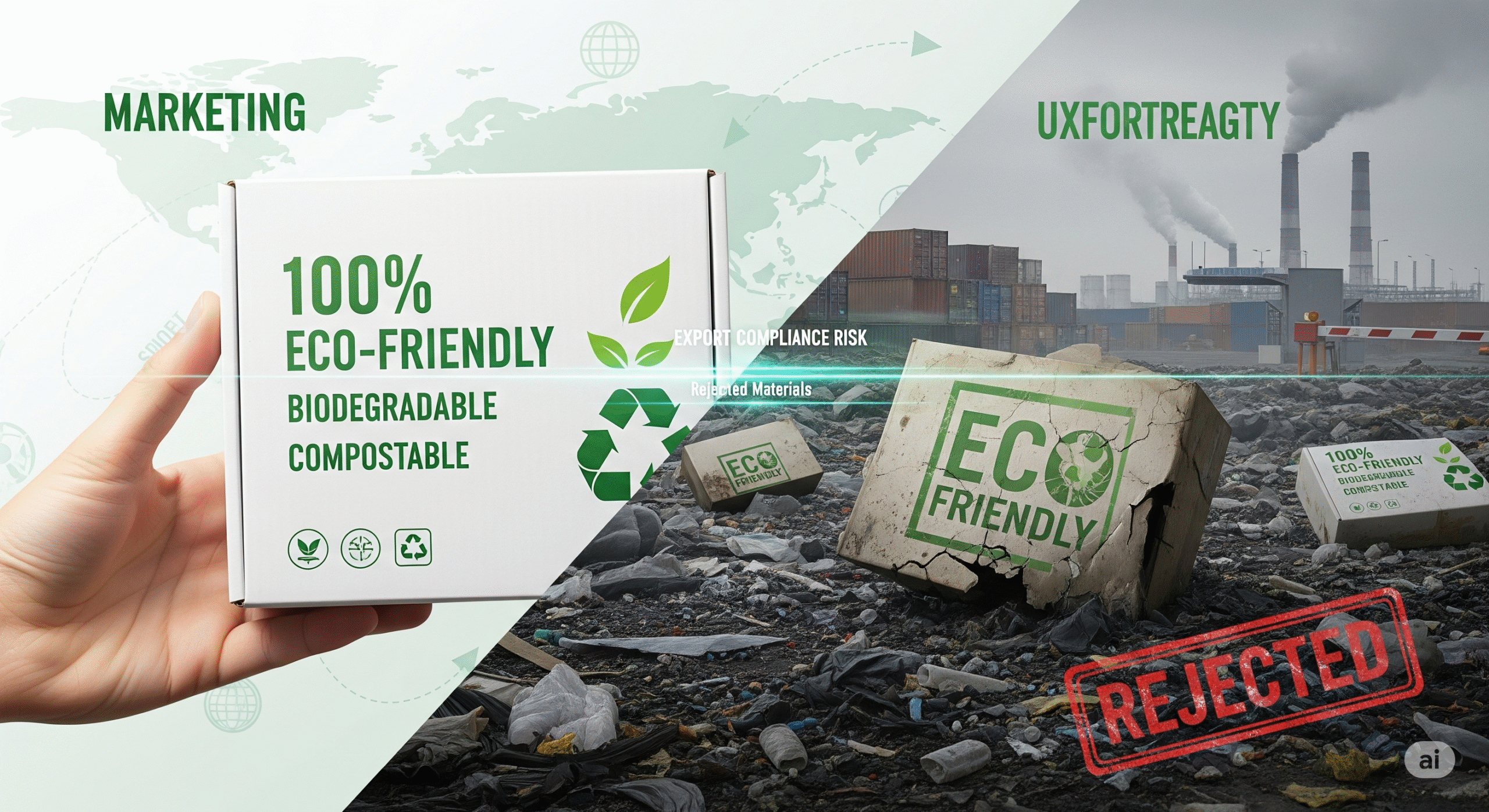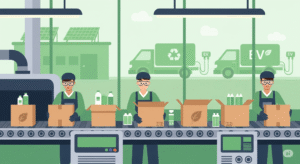Introduction: The $270 Billion Question
Is your packaging actually eco-friendly or just wearing a green halo?
In an era where “sustainable” is the sexiest word on the shelf, brands are racing to wrap their products in recycled kraft, plant-based film, or packaging adorned with leafy logos and earthy tones. The global sustainable packaging market has swelled to a jaw-dropping $270 billion in 2024, and that number is still climbing. Consumers want it. Regulators demand it. And companies are scrambling to deliver it.
But as the industry rushes to paint itself green, something murky lurks beneath the surface: confusion.
Terms like biodegradable, compostable, and recyclable are used interchangeably often inaccurately. Packaging that looks eco-friendly may actually be unrecyclable. Materials marketed as compostable might not compost without an industrial facility. And navigating international export requirements? A minefield.
Amid the pressure to go green, myths have taken root and exporters are among the most vulnerable. One wrong assumption about recyclability or regulation can turn into supply chain delays, customs fines, or worse: a stain on your brand’s integrity.
So let’s set the record straight.
In this blog, we’re busting five of the most persistent myths about sustainable export packaging. Backed by current data, expert insight, and regulatory deep dives, this isn’t just another greenwashed listicle. It’s a reality check.
Because true sustainability isn’t about checking a box. It’s about understanding the full lifecycle of your packaging and making sure your eco-claims can actually hold up at customs.
Myth #1: Eco-Friendly Packaging Is Always More Expensive
At first glance, sustainable packaging often seems like a luxury. Bioplastics, recycled materials, compostable films all sound like budget-draining upgrades compared to traditional plastic or foam. This perception has hardened into a popular myth: “Eco = expensive.”
But here’s the truth: while the upfront cost of eco-friendly packaging can be higher, it’s only part of the story. When you zoom out and evaluate the full lifecycle from manufacturing to logistics to brand impact the numbers flip.
Let’s Talk Real Costs
Modern sustainable packaging isn’t just greener it’s often leaner.
- Reduced Operational Costs: Eco-packaging often uses less material and is more space-efficient. Lighter shipments mean lower transportation costs. Less volume means reduced storage requirements.
✅ Case in point: Floom saw a 15% cost reduction and 7% material savings after switching to eco-packaging. - Waste Management Savings: Traditional packaging materials especially plastics and composites are expensive to dispose of responsibly. Compostable or recyclable alternatives can significantly reduce landfill fees and long-term waste liabilities.
- Brand-Driven ROI: 82% of global consumers say they’d pay more for products in sustainable packaging. Among Gen Z? That number jumps to 90%. This isn’t fluff, it’s margin potential.
🧠 Sustainable packaging isn’t just good PR; it’s good pricing power. - Economies of Scale Are Kicking In: As demand accelerates, production costs for sustainable materials are dropping. The sustainable packaging sector is growing at a 6.1% CAGR, driving innovation and lowering prices across the board.
🧮 Total Cost of Ownership > Unit Price
Still stuck on material cost? That’s like judging a car solely on the sticker price without considering fuel economy, maintenance, or resale value. The same applies to packaging. Short-term savings from cheaper, unsustainable materials can lead to:
- Heavier shipping fees
- Non-compliance fines
- Damaged brand reputation
- Lost consumer trust
Bottom Line Takeaway:
Eco-packaging isn’t inherently expensive, short-sighted packaging choices are.
When you factor in logistics, waste, market expectations, and long-term brand positioning, sustainable packaging often comes out ahead. For exporters navigating complex markets and conscious consumers, this shift in mindset isn’t optional, it’s strategic.
Myth #2: All Biodegradable and Compostable Packaging Works the Same Way
Biodegradable and compostable might sound similar, but they are not the same and confusing them can lead to costly mistakes.
Biodegradable materials break down over time, but the process can take years and often leaves behind microplastics or toxins.
Compostable packaging, on the other hand, must decompose within a specific timeframe under controlled conditions, leaving no harmful residue and enriching the soil.
All compostable materials are biodegradable, but not all biodegradable materials are compostable and most compostables aren’t suited for home composting.
The Infrastructure Problem
Most compostable packaging requires industrial composting facilities environments with controlled temperature, oxygen, and moisture. These facilities are not widely available, and access is inconsistent across regions. In many cases, certified compostable packaging still ends up in landfill due to infrastructure gaps.
A 2024 study found that over 60% of plastics labeled “home compostable” failed to fully break down in actual home compost conditions.
The Risk for Exporters
Using materials with vague or inaccurate claims can lead to:
- Customs delays
- Rejected shipments
- Regulatory penalties
This is especially critical when exporting to markets with strict enforcement, like the EU, Canada, and Japan.
Bottom Line
Biodegradable is not a shortcut. Compostable isn’t a guarantee.
If you’re exporting eco-packaging, you must understand what the material actually does, how it’s processed in your destination market, and whether your claims hold up under scrutiny.
Otherwise, you’re not just risking sustainability you’re risking your shipment
Myth #3: Paper Is Always the Greener Choice
Paper has become the poster child of eco-friendly packaging. It feels natural, familiar, and guilt-free. But the reality is more nuanced and in some cases, paper may have a larger environmental footprint than plastic.
The Hidden Cost of “Natural”
Paper production is resource-intensive. It consumes:
- Large amounts of water
- Significant energy
- Forest resources, even when certified sustainable
A single paper bag can require four times the energy to produce compared to a plastic one. And if the paper isn’t recycled or recyclable (like wax-coated or laminated versions), it often ends up in landfill where it doesn’t degrade nearly as fast as you might expect.
When Plastic Performs Better
For certain export applications, plastic outperforms paper in durability, barrier protection, and weight efficiency. That means:
- Lower transport emissions
- Reduced food spoilage
- Better shelf life
In some scenarios, switching from a thin, recyclable plastic film to multi-layer paper packaging actually increases emissions and waste.
The Recycling Reality
Recycling rates for paper are higher than plastic in many regions but quality matters. Paper contaminated with food, grease, or chemicals is often rejected by recyclers. The same goes for laminated or coated paper materials used in export packaging.
The Risk for Exporters
Assuming paper is always preferable can backfire:
- Heavier shipments = higher transport emissions
- Poor durability = product damage or spoilage
- Contamination = lower recycling success
For exporters, it’s not about choosing between paper or plastic. It’s about making decisions based on life cycle analysis, end-use, and real-world infrastructure.
Bottom Line
Paper isn’t automatically better.
It depends on how it’s sourced, produced, used, and disposed of.
True sustainability comes from context-aware choices not assumptions.
Myth #4: Recyclable Means Recycled
Packaging marked “recyclable” often gets a free pass in sustainability discussions but recyclability doesn’t guarantee it will actually be recycled.
The Gap Between Theory and Reality
Just because a material can be recycled doesn’t mean it will be. The difference lies in:
- Local recycling infrastructure
- Consumer behavior
- Contamination during use or disposal
A 2023 global study found that less than 9% of plastic waste is actually recycled, despite much of it being technically “recyclable.”
Complex Materials, Low Recovery
Many export packages are made from multi-layer films or composite materials that combine paper, plastic, foil, or coatings. These are often labeled as recyclable but they’re not recyclable in most municipal systems.
If a material requires specialized separation or chemical processing, chances are it ends up in landfill.
Cleanliness Counts
Recyclability also depends on condition. If packaging is soiled with food or grease, it can contaminate entire recycling batches. For exporters, this risk multiplies especially with long-haul shipments involving perishables.
The Risk for Exporters
Assuming a “recyclable” label ensures sustainability can lead to:
- Reputational damage
- Non-compliance with regional waste regulations
- Customer backlash when packaging isn’t actually recyclable locally
Bottom Line
Recyclable ≠ Recycled.
To claim true sustainability, exporters must understand:
- Whether materials are actually recycled at the destination
- Whether design choices enhance or block that outcome
How disposal works in real conditions, not ideal ones
Myth #5: One Global Packaging Strategy Works Everywhere
Sustainability might be a global goal but packaging compliance, infrastructure, and consumer expectations are anything but uniform.
Regulations Vary by Market
What’s approved in one country may be restricted in another.
For example:
- The EU mandates strict compostability standards and labeling laws.
- Canada is phasing out hard-to-recycle plastics.
- Japan enforces tight waste separation rules and packaging minimalism.
Exporters relying on a single packaging format risk non-compliance, port delays, or market rejection.
Infrastructure Isn’t Equal
A package designed for industrial composting in Germany may end up in landfill in India, simply because the infrastructure isn’t there. Even recycling capabilities vary dramatically between cities let alone countries.
Failing to adapt packaging to destination infrastructure turns “eco-friendly” into empty branding.
Consumer Expectations Differ
Eco-conscious consumers in Scandinavia might expect refillable formats. In contrast, emerging markets may prioritize affordability and durability over sustainability claims.
Misalignment erodes trust and sales.
The Risk for Exporters
One-size-fits-all packaging can result in:
- Regulatory violations
- Loss of market access
- Reputational damage
- Unnecessary environmental impact
Bottom Line
Sustainability is local.
If you’re serious about global exports, your packaging strategy must be flexible, region-specific, and grounded in real-world logistics not global generalizations.
Conclusion: Green Isn’t Always Clean
Sustainable packaging is no longer a “nice-to-have.” It’s a $270B industry under global scrutiny and green claims come with real consequences.
What this means for exporters:
Eco-packaging isn’t just about the material. It’s about where it’s going, how it’s handled, and what your claims actually mean in every market you serve.
Let’s Recap the 5 Biggest Myths:
- “Sustainable” means the same thing everywhere – it doesn’t.
- Biodegradable and compostable are interchangeable – they’re not.
- Paper is always greener than plastic – not necessarily.
- Recyclable means it will be recycled – only sometimes.
- One packaging strategy fits all markets – it never does.
If you’re exporting, it’s time to move beyond the buzzwords.
Ask harder questions. Read the certifications. Design for the real world, not the label.
Because in 2025, sustainability isn’t just a selling point, it’s a supply chain responsibility.
Top 5 FAQ: Sustainable Export Packaging
1. Is “biodegradable” the same as “compostable”?
No. Biodegradable means the material can break down eventually but not always safely or quickly. Compostable materials must degrade within a specific time (usually 12 weeks) and leave no harmful residue. Most compostables also require industrial conditions to break down properly.
2. If packaging is labeled recyclable, is that enough?
Not necessarily. “Recyclable” doesn’t guarantee the material will be recycled. Local infrastructure, contamination, and composite materials all affect whether recycling is actually possible at the destination.
3. Isn’t paper always more eco-friendly than plastic?
It depends. Paper often has a higher production footprint and may not be more sustainable if it’s coated or non-recyclable. The full lifecycle of each material including energy use, water, transport, and end-of-life must be considered.
4. Can I use the same packaging for all export markets?
No. Regulations, waste infrastructure, and consumer expectations vary by region. What works in one country may violate laws or create waste in another. A one-size-fits-all strategy is risky and often ineffective.
5. How can I make sure my eco-packaging claims are compliant?
Only use certified materials that meet region-specific standards (e.g. EN13432, ASTM D6400). Avoid vague terms like “green” or “eco-friendly” without proof. Ensure that labels align with disposal realities in each market you ship to.


